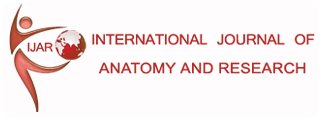IJAR.2017.104
Type of Article: Original Research
Volume 5; Issue 3.1 (July 2017)
Page No.: 4031-4035
DOI: https://dx.doi.org/10.16965/ijar.2017.104
EFFECT OF AQUEOUS EXTRACT OF CASSAVA (Manihot esulenta) LEAF ON THE MORPHOLOGY AND MICRO-ANATOMY OF THE LIVER OF WISTER RATS
Kebe E. Obeten *1, Saviour A. Odey 2, Gabriel Udo-Affah 1, Eluwa MA 1.
*1 Department of human anatomy, University of Calabar, Calabar
2 Department of Human anatomy, Cross River University of Technology, Okuku, CRS
Corresponding Author: Kebe E. Obeten, Department of Human Anatomy, Faculty of Basic Medical Sciences, University of Calabar, Calabar, Nigeria. E-Mail: obasikosisochukwu@yahoo.co.uk
ABSTRACT
Background and objective: Cassava leaves (Mannihot esculenta Crantz) are largely consumed as vegetable in Africa the present study explored the effect of aqueous leaf extract of Mannihot esculenta Crantz, on the microanatomy of the liver of adult Wistar rats.
Materials and methods: Twelve adult Wistar rats weighing 110-150g were distributed into three groups of four rats each. Group 1 served as the control group which received 0.3ml of normal saline, while group 2 (low dose group) received 0.2ml of the extract and group 3 (high dose group) received 0.5ml of the extract. The effect of the extract on the body weight and liver histology was evaluated. After the end of the administration (day 14), the weight were taking before sacrifice. The Liver were excised and fixed in 10% formal saline, and processed for rapid routine paraffin embedding. Tissues were stained with routine Haematoxylin and Eosin, observed under a light microscope and micrograph were taken.
Results: Result shows significant difference (p<0.05) in weight gain between control and the treated groups. In the low dose group histology revealed degenerative atrophic hepatocytes while sinusoidal dilatation was observed in the high dose group of the treated groups.
Conclusion: From the results obtained from the study, it could be deduced that; the administration of aqueous leaf extract of Manihot esculenta at the doses given induces observable pathological effect on the histology of the liver and may be concluded to have adverse effect on the dosage administered.
Key words: Cassava leaf, Wistar rat, Liver, Microanatomy.
REFERENCES
- Alves, A.A.C. and Setter, T.L. Response of cassava to water deficit: leaf area growth andabscisic acid. Crop Science 2002;40;131-137.
- Bradbury, J. H. and Holloway, W. D. Chemistry of tropical root crops: significance for nutrition and agriculture in pacific. 1988;ACIAR Monograph No 6.
- FAO, (1990). Roots, tubers, plantains and bananas in human nutrition.FAO, Rome, Italy. FAO, (2002). http://www.fao.org. Agricultural Statistics. Food and Agricultural Organization of the United Nations.Rome.
- Nweke, Felix I., Dunstan S. C. Spencer and John K. Lynam. The cassava transformation: Africa’s best kept secret. Lansing, Mich. 2002, USA: Michigan State University Press.
- Polsen RA and Spencer DSC. The technology adoption process in subsistence case for cassava in Southwestern Nigeria, Agric. Sys., 1991;36:65-78.
- Conn, E. E. Cyanogenesis- a personal perspective.In Bokanga, M., Essers, A. J. A.,Poulter, N., Rosling, H. and Tewe, O. (eds), Proceedings of the international workshop on cassava safety, March 1-4, 1994, Ibadan, Nigeria, Acta Horticulturae, 1994;375:31-43.
- Eggum, B.O. The protein quality of cassava leaves. British. Journal of Nutrition., 1970; 24:761-768.
- Adewusi SRA and Bradbury JH. Carotenoids in cassava; comparison of open column and HPLC methods of analysis. J. Sci. Food. Agri. 1993;62:375-383.
- Reed, J. D., R. E. McDowell, P. J. Van Soest and P. J. Horvath. Condensed tannin : sa factor limiting the use of cassava forage. J. Sci. Food Agric. 1982;33:2131.
- Akanji A. O. and Famuyiwa OO. The effects of chronic cassava consumption cyanide intoxication and protein malnutrition on glucose tolerance in growing rat. British Journal of Nutrition 1993;69(1):269-76
- Howlett, W.P., Brubaker, G.R., Mlingi, N., Rosling, H. Konzo, an epidemic upper motor neuron disease studied in Tanzania. Brain 1990;113:223–235.
- Atangwho IJ, Ebong PE, Eyong EU, William IO, Eteng MU, Egbung GE. Comparative Chemical Composition of Leaves Some Antidiabetic Medicinal Plants: Azadirachta indica, Vernonia amygdalina and Gongronema latifolium. Afr. J. Biotechnol. 2009;18:4685-4689.
- Tao Hai-Teng, Bin Qui, Fang-Ling Du et al., (2015). The protective effects of cassava (Maniho esculentta crantz) leaf flavonoid extracts on liver damage of carbon tetrachloride injured mice. Afr J. Tradit Complement Altern Med. 2015;12(1):52-56.
- Kahn CR, Granner DK et al. Control of hepatic gluconeogenesis through the transcriptional coactivator PGC-1. Nature 2001;413:131-138.
- Awe E. O and Koawole O. T. Biochemical, haematological and histophatological assessment of toxic effects of Manihot esculenta Crantz leaf aqueous extract in rats. Int J. Pharm Bio Sci 2013;4(3):228-235.








